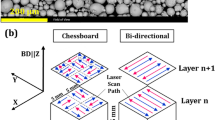Abstract
A decrease in the packet size or lath width of bainitic-martensitic steels produces a simultaneous increase of toughness and yield stress. Specific interpretations are necessary to give the actual relationships since classical theories of the grain size effect cannot be directly applied to both of these microstructural parameters. To obtain these specific interpretations, a detailed analysis of lath orientations inside a packet is necessary. This analysis reveals that assumptions such as all laths in any one packet are similarly oriented are unfounded and that in fact a packet contains many high angle lath boundaries which are given by laths adopting different Kurjumov-Sachs orientation variants during the γ → α transformation. The yield stress then depends on the average lath “diameter” which is a function of lath width and length, the latter dimension being related to the packet diameter. A Petch agreement is not found, rather the yield stress is found to be related to the reciprocal of the average lath diameter. A theoretical analysis shows that for very fine grain sizes, as encountered in bainites and martensites, macroscopically heterogeneous deformation (a necessary condition leading to the Petch formulation) tends to vanish and that for macroscopically homogeneous deformation the yield stress is expected to be related to the reciprocal of the grain diameter. The fracture transition temperature is determined by the particular fracture characteristics of these steels. It is possible to explain the fracture of bainite and lath martensite without recourse to concepts such as “effective grain size” or “covariant packet size”. In spite of the different lath orientations inside a packet, a brittle crack may adopt an average, approximately straight fracture direction across a packet by following a particular group of different fracture planes that are separated by low angle boundaries. At a packet boundary the crack must find another group of fracture planes, which will impose an important deviation of the crack. At the transition temperature, the controlling event in the fracture sequence is this crack deviation, which imposes an energy requirement for the crack to undergo high angle deviations across the first laths that are adjacent to the packet boundary, until the new average fracture direction is found. Using this model the transition temperature can be related to a logarithmic function of the product of the packet diameter and lath width.
Similar content being viewed by others
References
M. J. Roberts:Met. Trans., 1970, vol. 1, pp. 3287–94.
T. Inoue, S. Matsuda, Y. Okamura, and K. Aoki:Trans. Jpn. Inst. Met, 1970, vol. 11, pp. 36–43.
P. Brozzo, G. Buzzichelli, A. Mascanzoni, and M. Mirabile:Met. Sci., 1977, vol. 11, pp. 123–29. 4. F. B. Pickering: Symposium Transformation and Hardenability in Steels, Climax Molybdenum Co. and the University of Michigan, February 1967.
D. W. Smith and R. F. Hehemann:J. Iron Steel Inst, 1971, vol. 209, pp. 476–81.
K. J. Irivine and F. B. Pickering:J. Iron Steel Inst, 1958, vol. 188, pp. 101–12.
Y. Ohmori, H. Ohtani, and T. Kunitake:Trans. Iron Steel Inst. Jpn., 1972, vol. 12, pp. 146–54.
D. Guttmann and P. R. Krahe:Mém Sci. Rev. Métall., 1973, vol. 7-8, pp. 559–67.
V. Ohmori, H. Ohtani, and T. Kunitake: Trans. Iron Steel Inst. Jpn., 1971, vol. 11, pp. 250–59.
U. F. Kocks:Phil. Mag., 1966, vol. 13, pp. 541–66.
R. L. Fullman:Trans. AIME, 1953, vol. 197, pp. 447 and 1267.
W. R. Tyson:Acta Met, 1963, vol. 11, pp. 61–62.
G. R. Speich and P. R. Swann:J. Iron Steel Inst., 1965, vol. 203, pp. 480–85.
J. M. Chilton, C. J. Barton, and G. R. Speich:J. Iron Steel Inst., 1970, vol. 208, pp. 184–93.
C. A. Apple, R. N. Caron, and G. Krauss:Met. Trans., 1974, vol. 5, pp. 593–99.
S. Matsuda, T. Inoue, and M. Ogasawara:Trans. JIM, 1968, vol. 9, pp. 343–48.
U. Franzoni and A. Mascanzoni: Technical Report no. 2, European Community ECSC Res. Proj. Number: 7210-MA-4-402, 1977.
U. H. Lindborg and B. L. Averbach:Acta Met., 1966, vol. 14, pp. 1583–93.
J. P. Naylor and P. R. Krahe:Met. Trans. A, 1975, vol. 6A, pp. 594–98.
G. T. Hahn, B. L. Averbach, W. S. Owen, and M. Cohen:Fracture, p. 91, Technology Press of MIT, John Wiley and Sons Inc., N.Y., 1959.
N. J. Petch:ibid, Technology Press of MIT, John Wiley and Sons Inc., N.Y., 1959. p. 54.
A. H. Cottrell:Trans. TMS-AIME, 1958, vol. 212, pp. 192–203.
J. R. Low:Relation of Properties to Microstructure, p. 163, ASM, Cleveland, OH, 1954.
W. S. Owen: I.S.I. Special Report 81, pp. 1–9, 1963.
A. S. Tetelman and A. J. McEvily:Fracture of Structural Materials, John Wiley and Sons Inc., N.Y., 1967.
A. R. Cox:International Conf. on Strength of Metals and Alloys, Tokio, Spetember 1967.
R. W. Honeycombe and F. B. Pickering:Met. Trans., 1972, vol. 3, pp. 1099–1112.
G. Langford and M. Cohen:Trans. ASM, 1969, vol. 62, pp. 623–38.
E. Smith and P. J. Worthington:Phil. Mag., 1964, vol. 9, pp. 211–16.
J. D. Eshelby, F. C. Frank, and F. R. N. Nabarro:Phil. Mag., 1951, vol. 42, pp. 351–64.
B. A. Bilby and R. Bullough:Phil. Mag., 1954, vol. 45, pp. 631–46.
J. Friedel:Les dislocations, Gauthier-Villars, Paris, 1956.
Author information
Authors and Affiliations
Additional information
Formerly at the Centre des Matériaux de l’Ecole Nationale Supérieure des Mines de Paris.
Rights and permissions
About this article
Cite this article
Naylor, J.P. The influence of the lath morphology on the yield stress and transition temperature of martensitic- bainitic steels. Metall Trans A 10, 861–873 (1979). https://doi.org/10.1007/BF02658305
Received:
Issue Date:
DOI: https://doi.org/10.1007/BF02658305




